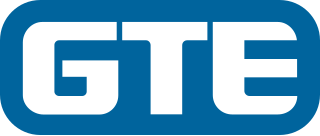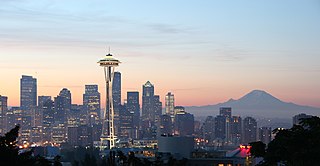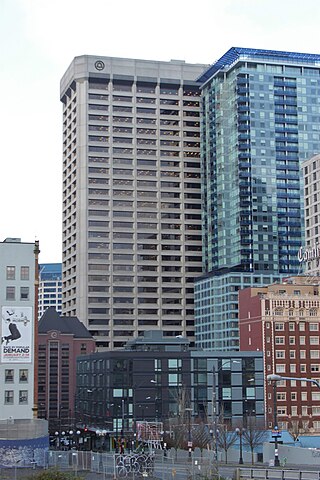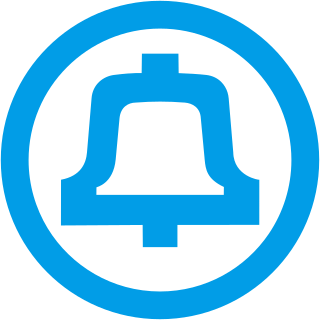
GTE Corporation, formerly General Telephone & Electronics Corporation (1955–1982), was the largest independent telephone company in the United States during the days of the Bell System. The company operated from 1926, with roots tracing further back than that, until 2000, when it was acquired by Bell Atlantic; the combined company took the name Verizon.

The Pacific Northwest (PNW), sometimes referred to as Cascadia, is a geographic region in western North America bounded by its coastal waters of the Pacific Ocean to the west and, loosely, by the Rocky Mountains to the east. Though no official boundary exists, the most common conception includes the U.S. states of Oregon, Washington, northern Idaho, and the Canadian province of British Columbia. Some broader conceptions reach north into Alaska and Yukon, south into northern California, and east into western Montana. Other conceptions may be limited to the coastal areas west of the Cascade and Coast mountains.

A Regional Bell Operating Company (RBOC) was a corporate entity created as result of the antitrust lawsuit by the U.S. Department of Justice against the American Telephone and Telegraph Company (AT&T) in 1974 and settled in the Modification of Final Judgment on January 8, 1982.

The Burlington Northern Railroad was a United States-based railroad company formed from a merger of four major U.S. railroads. Burlington Northern operated between 1970 and 1995.
The Pacific Bell Telephone Company (Pac Bell) is a telephone company that provides telephone service in California. The company is owned by AT&T through AT&T Teleholdings, and, though separate, is now marketed as “AT&T”. The company has been known by a number of names during which its service area has changed. The formal name of the company from the 1910s through the 1984 Bell System divestiture was The Pacific Telephone and Telegraph Company. As of 2002, the name “Pacific Bell” is no longer used in marketing, although Pacific Bell is still the holder of record for the infrastructure of cables and fiber through much of California.
US West, Inc., doing business as U S West, was one of seven Regional Bell Operating Companies, created in 1983 under the Modification of Final Judgement, a case related to the antitrust breakup of AT&T. US West provided local telephone and intraLATA long-distance services, data transmission services, cable television services, wireless communications services and related telecommunications products to defined areas in Arizona, Colorado, Idaho, Iowa, Minnesota, Montana, Nebraska, New Mexico, North Dakota, Oregon, South Dakota, Utah, Washington, and Wyoming. US West was a public company traded on the New York Stock Exchange under the ticker symbol "USW" with headquarters at 1801 California Street in Denver, Colorado.

The breakup of the Bell System was mandated on January 8, 1982, by a consent decree providing that AT&T Corporation would, as had been initially proposed by AT&T, relinquish control of the Bell Operating Companies, which had provided local telephone service in the United States. This effectively took the monopoly that was the Bell System and split it into entirely separate companies that would continue to provide telephone service. AT&T would continue to be a provider of long-distance service, while the now-independent Regional Bell Operating Companies (RBOCs), nicknamed the "Baby Bells", would provide local service, and would no longer be directly supplied with equipment from AT&T subsidiary Western Electric.

Northwest Fiber, LLC, doing business as Ziply Fiber, is an American telecommunications company based in Kirkland, Washington. Ziply is a subsidiary of WaveDivision Capital, a private investment company, which is also Kirkland-based. The company started operations on May 1, 2020, when it completed its acquisition of Frontier Communications Northwest operations and assets for $1.4 billion; Frontier sold its Northwest operations after filing for bankruptcy protection in April 2020. Ziply Fiber's footprint covers the Pacific Northwest region, specifically the states of Washington, Oregon, Idaho and Montana. Its key offerings include fiber internet and phone for residential customers, Business Fiber Internet, and Ziply Voice services for small businesses; and a variety of internet, networking and voice solutions for enterprise customers. The company will also continue to support DSL and grandfathered TV customers. Ziply has stated that it plans on investing $500 million to improve its network and service throughout its footprint. This includes the goal of bringing fiber to nearly 85% of its network, which mainly encompasses rural communities. As of June 2020, approximately 30% have access to fiber.
Qwest Corporation is a former Regional Bell Operating Company owned by Lumen Technologies. It was formerly named U S WEST Communications, Inc. from 1991 to 2000, and also formerly named Mountain States Telephone and Telegraph Company from 1911 to 1991. It includes the former operations of Malheur Bell, Northwestern Bell and Pacific Northwest Bell as well.
West Coast Airlines was an airline linking small cities in the Pacific Northwest with larger cities in Washington, Oregon, Idaho, Utah, Montana, California and north to Alberta in Canada. It was headquartered in the Westlake area of Seattle, Washington.
Malheur Home Telephone Company, commonly known as Malheur Bell, was a rural telephone company operating in Oregon. It was a wholly owned subsidiary of Qwest Corporation, the Bell Operating Company of Qwest Communications International.
Comcast MO Group, Inc. was created by US WEST Inc., one of the original Baby Bells Regional Bell Operating Companies, acquisition of Boston-based Continental Cable and combined with its previously acquired Atlanta-based Wometco/GTC. Wometco/GTC adopted the MediaOne name a year earlier. Media One Group was acquired in 2000 by AT&T Broadband, which was subsequently acquired by Comcast in 2002.

1600 Seventh is a 32-story, 498 ft (152 m) skyscraper in Seattle, Washington, United States. Designed by John Graham & Company, it was completed in 1976; as of 2022, it is the 22nd-tallest building in the city. Originally built as the headquarters of Pacific Northwest Bell, it was first known as the Pacific Northwest Bell Building during construction and subsequently as 1600 Bell Plaza upon opening; it was later known as Bell Plaza and Qwest Plaza under US West and Qwest ownership.

Qwest Communications International, Inc. was a United States telecommunications carrier. Qwest provided local service in 14 western and midwestern U.S. states: Arizona, Colorado, Idaho, Iowa, Minnesota, Montana, Nebraska, New Mexico, North Dakota, Oregon, South Dakota, Texas, Utah, Washington, and Wyoming.

The Bell System was a system of telecommunication companies, led by the Bell Telephone Company and later by the American Telephone and Telegraph Company (AT&T), that dominated the telephone services industry in North America for over 100 years from its creation in 1877 until its antitrust breakup in 1983. The system of companies was often colloquially called Ma Bell, as it held a vertical monopoly over telecommunication products and services in most areas of the United States and Canada. At the time of the breakup of the Bell System in the early 1980s, it had assets of $150 billion and employed over one million people.
Lumen Technologies, Inc. is an American telecommunications company headquartered in Monroe, Louisiana, that offers communications, network services, security, cloud solutions, voice, and managed services. The company was a member of the Fortune 500 and the S&P 500 index from 1999 until 2023. Its communications services include local and long-distance voice, broadband, Multi-Protocol Label Switching (MPLS), private line, Ethernet, hosting, data integration, video, network, public access, Voice over Internet Protocol (VoIP), information technology, and other ancillary services. Lumen also serves global enterprise customers across North America, Latin America, EMEA, and Asia Pacific.
Pacific Telecom, Inc., originally Telephone Utilities, Inc. and now CenturyTel of the Northwest, Inc., was an independent telephone company that owned over 600,000 telephone lines in 12 states prior to its acquisition by CenturyTel.








